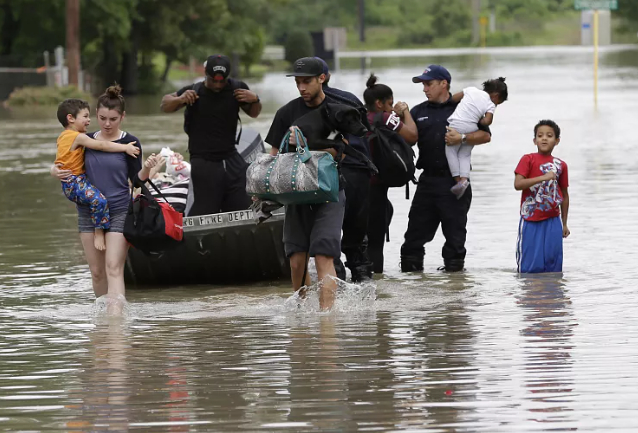November 26, 2025 | 19:39 GMT +7
November 26, 2025 | 19:39 GMT +7
Hotline: 0913.378.918
November 26, 2025 | 19:39 GMT +7
Hotline: 0913.378.918

El Niño can cause flooding in parts of the US. Photo: David J. Phillip/AP
El Niño is back, and it could push the world past a new average temperature record.
The global weather phenomenon refers to when waters in the Pacific Ocean become much warmer than usual.
After three years of the cooling La Niña weather pattern, the US National Oceanic and Atmospheric Administration (NOAA) announced on Thursday that El Niño is now underway.
"El Niño is normally associated with record breaking temperatures at the global level. Whether this will happen in 2023 or 2024 is not yet known, but it is, I think, more likely than not," says Carlo Buontempo, director of the EU's CopernicusHere’s how climate scientists predict El Niño will affect global temperatures, weather and marine life.
What is El Niño?
The El Niño climate event is responsible for raising global temperatures and aggravating extreme weather events.
It is caused by ocean temperatures and winds in the Pacific that oscillate between warming El Niño and cooling La Niña.
This year is already predicted to be hotter than 2022 and the fifth or sixth hottest year on record.
The effects of El Niño take months to be felt and may mean 2024 breaks temperature records.
The world's hottest year on record so far was 2016, coinciding with a strong El Niño - although climate change has fuelled extreme temperatures even in years without the phenomenon.
The last eight years were the world's eight hottest on record - reflecting the longer-term warming trend driven by greenhouse gas emissions.
How does El Niño affect the weather?
El Niño pushes warm water in the Pacific Ocean eastwards, causing the Pacific jet stream to move south of its neutral position.
This produces dryer and warmer weather in northern US and intense rainfall and flooding in the US Gulf Coast and Southeast.
In Europe, it can lead to colder, drier winters in the north and wetter winters in the south.
During the phenomenon, the global temperature increases by around 0.2 degrees Celsius, according to NOAA.
This could mean breaking the crucial 1.5 degrees Celsius global warming limit.
“The probability of having the first year at 1.5 degrees Celsius in the next five-year period is now about 50:50,” Professor Adam Scaife at the UK Met Office told the Guardian.
As a result, the world will face more intense heatwaves, prolonged hot seasons and more powerful storms.
The first places to feel the effects will be countries close to the Pacific, like the west coast of the Americas, Japan, Australia and New Zealand.
Indonesia and Australia will likely experience hotter and drier weather with a greater possibility of wildfires.
Monsoons in India and rains in South Africa might be reduced while east Africa could get more rains and flooding.
El Niño also increases hurricane activity in the Pacific meaning places like Hawaii will be at risk of tropical cyclones.
How does El Niño affect sea life?
El Niño also endangers marine life along the Pacific Coast. In normal conditions, a phenomenon known as 'upwelling' brings cool, nutrient-rich water up from the ocean depths.
When El Niño occurs, this process is suppressed or halted completely. This means fewer phytoplankton along the coast resulting in less food for certain fish.
In March, scientists found that global sea surface temperatures were at a record high. El Niño is likely to exacerbate the situation.
There is a 56 per cent chance that when the weather phenomenon is at peak strength, the Eastern-Pacific sea surface temperatures will be at least 1.5 degrees Celsius higher than normal, according to NOAA.
Warmer water causes bleaching in coral reefs leaving them at greater risk of starvation.
(ERN)

(VAN) A new study reveals how the simultaneous effects of ocean acidification, salinity and loss of oxygen are making the world more fragile.

(VAN) Hopes are growing that the creation of the first 3D turkey gut model could be a turning point in the battle against the virulent blackhead disease.

(VAN) Tyson, America’s biggest meat supplier, plans to shutter one of its largest beef processing plants as the industry continues to struggle with low cattle supplies and political pressure from Washington.

(VAN) New FAO study shows how digital solutions are empowering farmers and fishers to prevent losses and build resilient agrifood systems.

(VAN) Brazil's COP30 presidency pushed through a compromise climate deal on Saturday that would boost finance for poor nations coping with global warming but that omitted any mention of the fossil fuels driving it.

(VAN) Poultry farmers in the UK have been warned that they could face one of the worst winters yet for bird flu.

(VAN) Prices of main-crop paddy have risen sharply, with jasmine rice hitting 16,100 baht per tonne — the highest level in years.